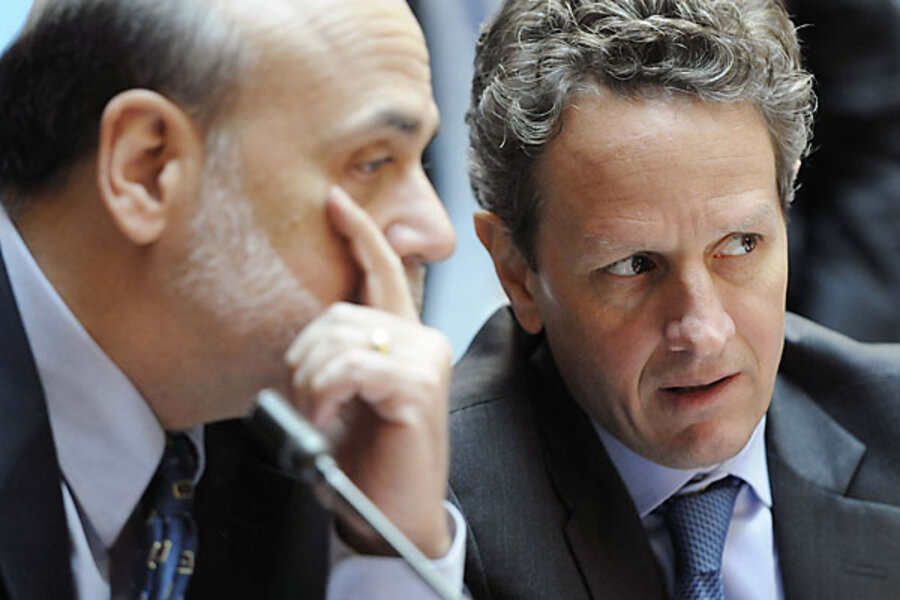Interest rates: Will the Fed signal a boost?
Loading...
WASHINGTON (AP) — The door at the notoriously secretive Federal Reserve is opening wider.
For the first time in the Fed's 98-year history, its chairman is to begin holding regular news conferences. For Ben Bernanke, Wednesday's meeting with the press gives him a chance to steer the debate about where hiring, economic growth and inflation are headed in the months ahead.
It also helps the chairman cast himself as open and accessible, eager to answer questions.
Investors will be looking mainly for clues about when the Fed will reverse course and begin boosting interest rates.
When their two-day meeting ends Wednesday, before the news conference begins, Bernanke and his colleagues are expected to signal that the Fed's $600 billion Treasury bond-buying program will end as scheduled in June.
The bond-buying program was intended to keep interest rates low, encourage spending and boost growth. But critics say increased spending has raised the risk of high inflation.
Since the Fed announced the economic-support program in November, the economy has improved. Unemployment has fallen to 8.8 percent. And the private sector over the past two months has embarked on its biggest hiring spree in five years.
But a spike in oil and food prices has pushed inflation up. That's sparked a debate within the Fed about when to start raising rates and take other steps to soak up the money pumped into the economy during the recession.
A vocal minority, including the Fed regional chiefs in Philadelphia and Minneapolis, say the Fed may need to raise interest rates by the end of this year to fight inflation. The central bank has kept its benchmark interest rate near zero since December 2008.
And Richard Fisher, president of the Federal Reserve Bank of Dallas, argues that the Fed should consider halting the bond-buying program now, not in June.
The majority — including Bernanke, vice chairwoman Janet Yellen and William Dudley, president of the Federal Reserve Bank of New York — say interest rates should stay low longer, and the bond-buying program should run its course.
Bernanke has predicted that the jump in oil and food prices will cause only a brief increase in consumer inflation. Excluding those prices, which tend to fluctuate sharply, inflation is still low, he has argued.
So far this year, Bernanke has managed to forge consensus for his policies. All the Fed's decisions this year have been unanimous. But the deepening divides could make Bernanke's job harder.
The latest policy announcement is expected around 12:30 p.m. EDT (1630 GMT). Less than two hours later, Bernanke will make history and hold the first of three news conferences this year. Seated at a wooden desk, he will field questions for around 45 minutes.
The news conference allows Bernanke to control the Fed's message. But the strategy could backfire if he says something confusing or rattles Wall Street.
"Even people as smart as Bernanke are human and sometimes make slips," said Alan Blinder, a Princeton economist and former Fed vice chairman. Financial markets "are ready to panic at the slightest provocation."
Bernanke, who's spent most of his professional life in academia teaching economics at Princeton and other institutions, likes explaining complex subjects. He also has had plenty of experience handling questions from critics in Congress and on CBS' TV news magazine show "60 Minutes."
Bernard Baumohl of the Economic Outlook Group thinks Bernanke will steer clear of making any major news at the conference. Baumohl suggested that the news media's build-up to the news conference was "starting to rival that of the upcoming royal wedding in England."
To prep for his debut, Bernanke has watched videos of how his counterparts in Europe — Jean-Claude Trichet, president of the European Central Bank, and Mervyn King, head of the Bank of England — have answered questions at news conferences.
Two months ago at a meeting of finance officials in Paris, Bernanke pulled aside Trichet and King to discuss how they manage such events.
At his news conference, Bernanke also will discuss the Fed's updated economic forecasts. The Fed is expected to slightly lower its forecast for growth this year, bump-up its inflation estimate and upgrade its outlook for employment.
Economic growth likely slowed sharply in the January-March quarter as bad weather and a spike in oil prices weighed on consumer and business spending. The economy is expected to regain strength over the rest of the year. But the first-quarter slowdown means a bit less growth for all of 2011 than the range of 3.4 percent to 3.9 percent the Fed had forecast in late January.
Higher food and energy prices will cause the Fed to forecast slightly faster inflation for this year than the 1.3 percent to 1.7 percent increase previously estimated.
And the faster pace of hiring in the first three months of this year will prompt the Fed to forecast a lower unemployment rate by year's end. In January, it had forecast a rate of 8.8 percent to 9 percent.
___
AP Economics Writer Paul Wiseman contributed to this report.





